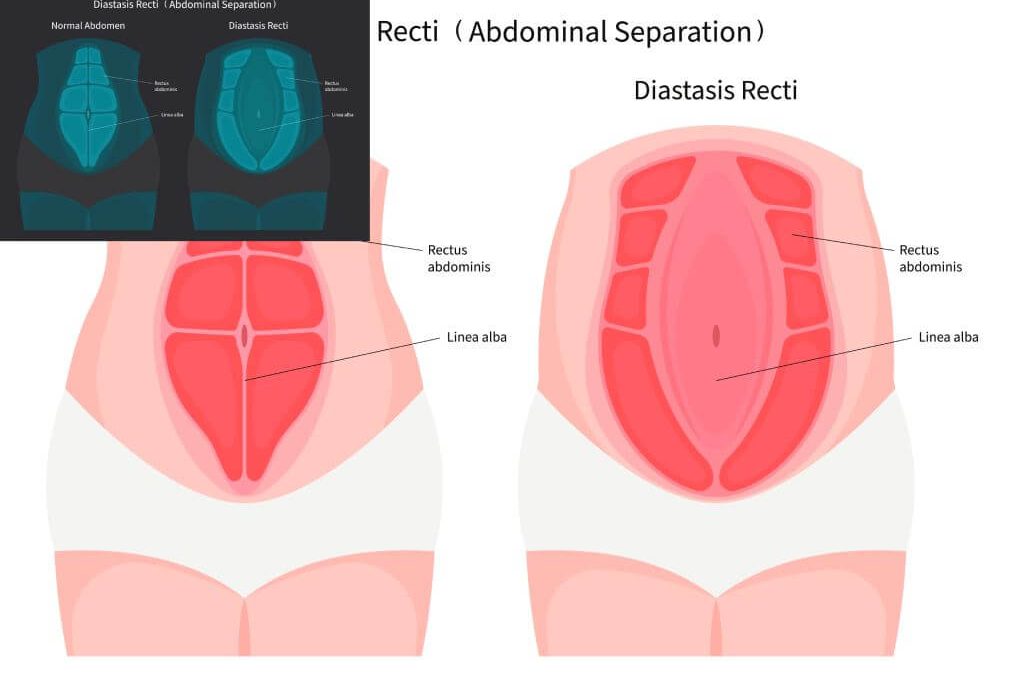What is Diastasis Recti?
Diastasis Recti is a condition commonly encountered during and after pregnancy, where the rectus abdominis muscles (commonly referred to as the “six-pack” muscles) separate along the midline. This separation is due to the stretching of the linea alba, the connective tissue that runs vertically between these muscles. While it is a natural adaptation during pregnancy to accommodate a growing baby, in many new mothers, the abdominal wall may not return to its pre-pregnancy state without intervention.
As physiotherapists, our role in identifying, assessing, and managing Diastasis Recti is crucial for helping new mothers regain core strength, prevent complications, and return to functional activities safely.
Understanding Diastasis Recti in the Physiotherapy Context
From a physiotherapy standpoint, Diastasis Recti is more than a cosmetic concern. It affects:
- Core Stability
- Postural Control
- Pelvic Floor Function
- Breathing Mechanics
- Spinal Support
When left unaddressed, it may contribute to lower back pain, pelvic dysfunction, and delayed postnatal recovery.
Prevalence and Incidence of Diastasis Recti
General Prevalence
- Diastasis Recti is particularly prevalent among postpartum women.
- Up to 60% of women experience some degree of abdominal separation during the third trimester of pregnancy.
- 30–40% continue to show signs of Diastasis Recti 6–8 weeks postpartum, and for some, the condition can persist for months or even years without treatment.
Other Affected Groups
- Though most common in postnatal women, Diastasis Recti can also occur in men and women exposed to chronic increases in intra-abdominal pressure—such as from obesity, heavy lifting, or chronic coughing.
- Pregnancy, however, remains the primary contributing factor.
Age and Risk Factors
- The condition most commonly affects women aged 25 to 40, coinciding with typical childbearing years.
- Younger and older mothers are also susceptible, especially those with:
– Multiple pregnancies
– Large babies
– Cesarean deliveries - In older women, decreased tissue elasticity can contribute to more severe separation and slower recovery.
Statistical Highlights
- Prevalence increases from 33.1% at 21 weeks of gestation to 60% by 6 weeks postpartum.
- On average, about 6 in 10 women experience Diastasis Recti during or after pregnancy.
- Younger individuals (<45 years) show a higher prevalence (50.9%) compared to the elderly (>45 years) at 24.6%.
- The overall prevalence across populations is estimated at 28.4%.
Physiotherapy Assessment of Diastasis Recti
The first step in managing Diastasis Recti is a thorough assessment. This typically includes:
Manual Palpation
Functional Assessment
Evaluating core strength, posture, breathing patterns, and pelvic floor function.
Ultrasound (where available)
How Physiotherapy Helps: Evidence-Based Intervention
- Individualized Exercise Programs
The cornerstone of physiotherapy management is a progressive exercise regimen focused on:– Deep Core Activation (especially the transversus abdominis and pelvic floor muscles)
– Breathing Retraining (to coordinate diaphragm, core, and pelvic floor)
– Postural Re-education (to reduce intra-abdominal pressure)
– Gradual Progression to more functional and global strengthening exercises
Exercises like abdominal drawing-in, pelvic tilts, modified planks, and supported bridges are often introduced in early stages and adapted as strength improves.
- Pelvic Floor Integration
As the abdominal wall and pelvic floor work in synergy, physiotherapists integrate pelvic floor strengthening (e.g., Kegel exercises) with abdominal rehabilitation to improve overall core stability. - Postural and Ergonomic Training
Teaching mothers proper body mechanics during daily activities such as lifting the baby, feeding, and transitioning from lying to sitting helps minimize abdominal strain. - Manual Therapy and Taping
Some physiotherapists may incorporate soft tissue mobilization, myofascial release, or abdominal taping techniques to support muscle re-education and reduce discomfort. - Education and Self-Management
A key component of physiotherapy is empowering mothers with knowledge about safe movements, red flags to watch for, and long-term strategies to maintain abdominal health.
When to Refer to Physiotherapy?
Mothers should ideally be screened at their postnatal check-up (usually 6 weeks post-delivery). Referral to physiotherapy is recommended if:
- There is a visible or palpable gap greater than 2 finger-widths
- Bulging or doming of the abdominal wall occurs during movement
- They experience lower back or pelvic pain
- There is pelvic floor dysfunction (incontinence, heaviness)
Conclusion
Diastasis Recti is a common but manageable condition among new mothers. Physiotherapy plays a pivotal role in restoring function, preventing complications, and promoting long-term wellness. Early assessment, tailored rehabilitation, and patient education are key components of effective physiotherapy intervention.
By addressing Diastasis Recti through a holistic and evidence-based approach, physiotherapists not only support physical recovery but also enhance the confidence and quality of life for new mothers.


